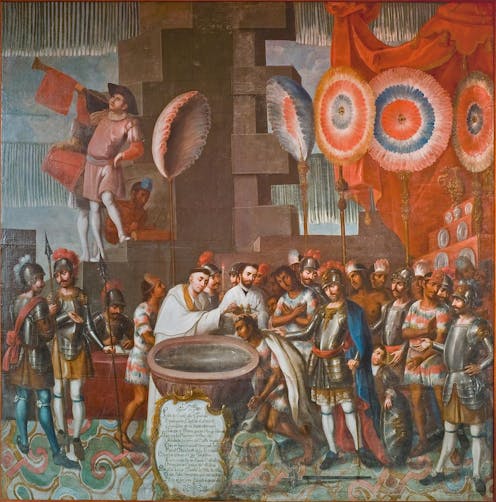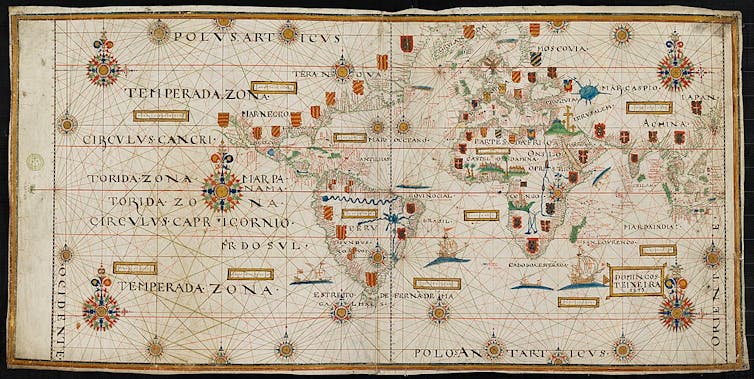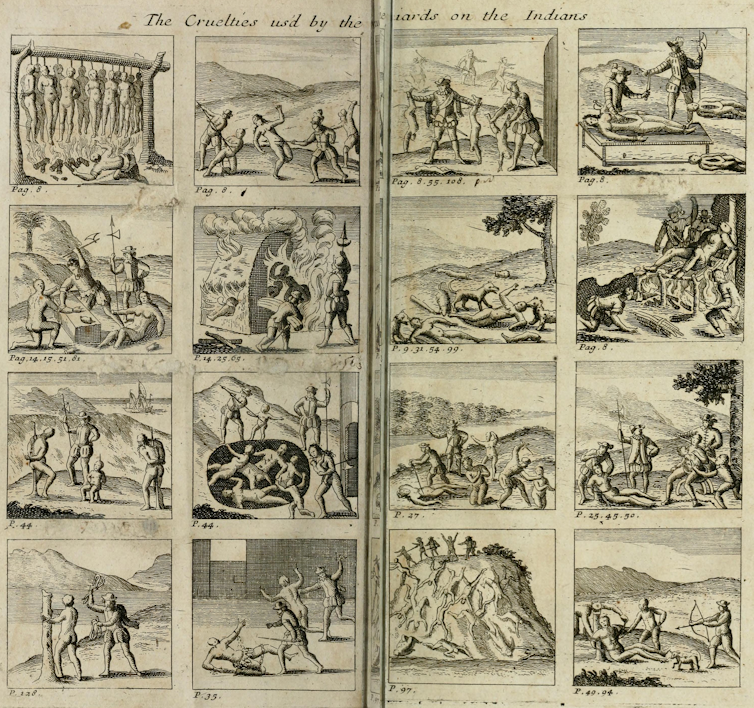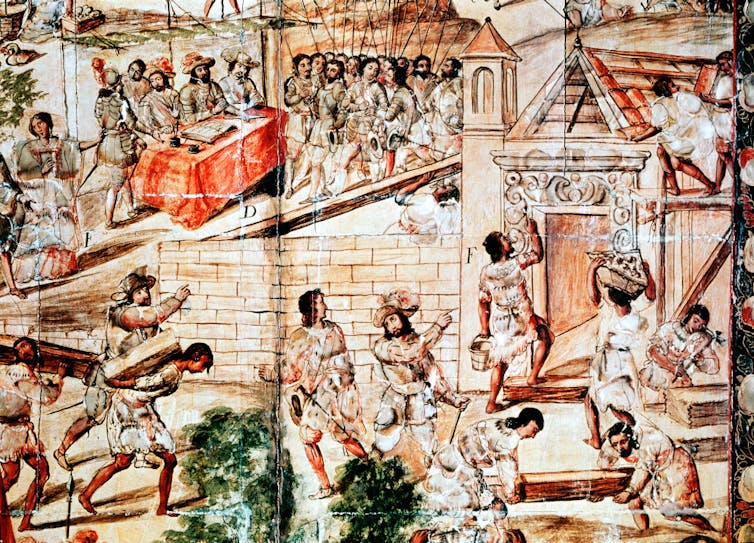Accept our king, our god − or else: The senseless ‘requirement’ Spanish colonizers used to justify t
The Requerimiento, a 16th-century document, sheds light on the deeper ideas and laws that the Spanish used to take over the New World.

Across the United States, the second Monday of October is increasingly becoming known as Indigenous Peoples Day. In the push to rename Columbus Day, Christopher Columbus himself has become a metaphor for the evils of early colonial empires, and rightly so.
The Italian explorer who set out across the Atlantic in search of Asia was a notorious advocate for enslaving the Indigenous Taínos of the Caribbean. In the words of historian Andrés Reséndez, he “intended to turn the Caribbean into another Guinea,” the region of West Africa that had become a European slave-trading hub.
By 1506, however, Columbus was dead. Most of the genocidal acts of violence that defined the colonial period were carried out by many, many others. In the long shadow of Columbus, we sometimes lose sight of the ideas, laws and ordinary people who enabled colonial violence on a large scale.
As a historian of colonial Latin America, I often begin such discussions by pointing to a peculiar document drafted several years after Columbus’ death that would have greater repercussions for Indigenous peoples than Columbus himself: the Requerimiento, or “Requirement.”
Catch-22
In 1494, the Treaty of Tordesillas infamously divided much of the world beyond Europe into two halves: one for the Spanish crown, the other for the Portuguese. Spaniards lay claim to almost the entirety of the Americas, though they knew almost nothing about this vast domain or the people who lived there.

In order to inform Indigenous people that they had suddenly become vassals of Spain, King Ferdinand and his councilors instructed colonizers to read the Requerimiento aloud upon first contact with all Indigenous groups.
The document presented them with a choice that was no choice at all. They could either become Christians and submit to the authority of the Catholic Church and the king, or else:
“With the help of God, we shall powerfully enter into your country, and shall make war against you in all ways and manners that we can … we shall take you and your wives and your children and shall make slaves of them … the deaths and losses which shall accrue from this are your fault.”
It was a catch-22. According to the document, Indigenous people could either voluntarily surrender their sovereignty and become vassals or bring war upon themselves – and perhaps lose their sovereignty anyway, after much bloodshed. No matter what they chose, the Requerimiento supplied the legal pretext for forcibly incorporating sovereign Indigenous peoples into the Spanish domain.
At its core, the Requerimiento was a legal ritual, a performance of possession – and it was unique to early Spanish imperialism.
‘As absurd as it is stupid’
But for all of its seeming authority, the reading of the Requerimiento was an absurd exercise. It first occurred at what is now Santa Marta, Colombia, during the expedition led by Pedrarias Dávila in 1513. An eyewitness, the chronicler Gonzalo Fernández de Oviedo, stated the obvious: “we have no one here who can help [the Indigenous people] understand it.”
Even with a translator, though, the document – with its lofty references to the Biblical creation of the world and papal authority – would hardly be intelligible to people unfamiliar with the Spaniards’ religion. Explaining the convoluted document would require nothing less than a long recitation of Catholic history.
Oviedo suggested that to deliver such a lecture, you’d have to first capture and cage an Indigenous person. Even then, it would be impossible to verify whether the document had been fully understood.
However, for the Requerimiento’s greatest critic, Bartolomé de las Casas, translation was merely one of many problems. A missionary from Spain, Las Casas criticized the spurious requirement itself: that a people should be expected to immediately convert to a religion they have only just learned exists, and
“swear allegiance to a king they have never heard of nor clapped eyes on, and whose subjects and ambassadors prove to be cruel, pitiless and bloodthirsty tyrants. … Such a notion is as absurd as it is stupid and should be treated with the disrespect, scorn and contempt it so amply deserves.”
Las Casas, who documented abuses against Indigenous people in multiple books and speeches, was one of the most outspoken denouncers of Spanish cruelty in the Americas. While he believed Spaniards had a right and even an obligation to convert Indigenous people to Catholicism, he did not believe that conversion should be done under the threat of violence.

Wars and forced settlement
Indigenous people responded to the Requerimiento in numerous ways. When the Chontal Maya of Potonchan – a Maya capital now part of Mexico – heard the conquistador Hernando Cortés read the document three consecutive times, they answered with arrows. After Cortés captured the town, they agreed to become Christian vassals of Spain on the condition that the Spaniards “leave their land.” When Cortés’ men remained after three days, the Chontal Maya attacked again.
Farther north, Spanish expeditioners Alvar Núñez Cabeza de Vaca and Melchior Díaz used the Requerimiento to forcibly relocate various Indigenous groups.
A bloodthirsty governor of the province, Nuño Beltrán de Guzmán – so violent that the Spanish themselves imprisoned him for abuses of power – had driven Indigenous residents out of the Valley of Culiacan in a series of brutal wars. But in 1536, Cabeza de Vaca and Díaz forced several groups, including the Tahue, to repopulate the valley after convincing them to accept the terms of the Requerimiento.
Resettlement would enable the collection of tribute and conversion to Catholicism. It was simply easier to assign missionaries and tribute collectors to established Hispanic townships than to mobile communities spread out across vast territories.
Cabeza de Vaca encouraged Indigenous leaders to accept the proposition by claiming that their god, Aguar, was the same as the Christians’, and so they should “serve him as we commanded.” In such cases, conversion to Catholicism was just as farcical as the Requerimiento itself.
Violence and colonial legacy
Even when Indigenous people accepted the Requerimiento, however, Las Casas wrote that “they are (still) harshly treated as common slaves, put to hard labor and subjected to all manner of abuse and to agonizing torments that ensure a slower and more painful death than would summary execution.” In most cases, the Requerimiento was simply a precursor to violence.

Dávila, the conquistador of present-day northern Colombia, once read it out of earshot of a village just before launching a surprise attack. Others read the Requerimiento “to trees and empty huts” before drawing their swords. The path to vassalage was paved in blood.
These are the truest indications of what the Requerimiento became on the ground. Soldiers and officials were content to violently deploy or discard royal prerogatives as they pleased in their pursuit of the spoils of war.
And yet, despite the viciousness, many Indigenous peoples survived by stringing their bows like the Chontal Maya, or negotiating a new relationship with Spain like the Tahue of Culiacan. Tactics varied greatly and changed over time.
Many Indigenous nations that exercised them survive today, long outliving the Spanish Empire – and the people who carried the Requerimiento on their crusade across the Americas.
Diego Javier Luis does not work for, consult, own shares in or receive funding from any company or organization that would benefit from this article, and has disclosed no relevant affiliations beyond their academic appointment.
Read These Next
Midlife weight gain can start long before menopause – but you can take steps early on to help your b
What you do in the years leading up to menopause can help counter the natural hormonal effects of aging,…
From truce in the trenches to cocktails at the consulate: How Christmas diplomacy seeks to exploit s
World leaders like to talk up peace at Christmastime. But alongside the tales of seasonal breaks in…
As millions of Americans face a steep rise in health insurance costs, lawmakers continue a century-l
US health care policy will remain fractured until lawmakers address the core question of who is responsible…






